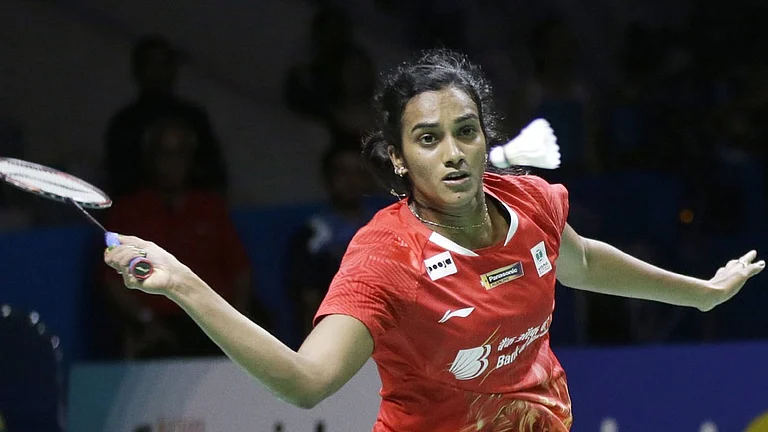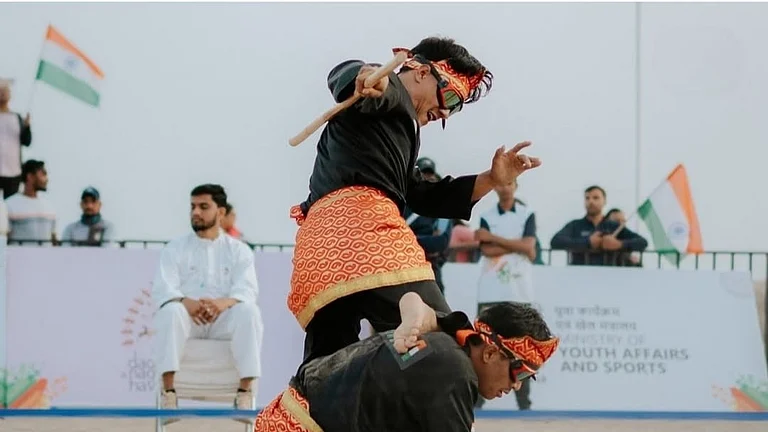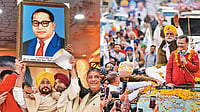It is a typically mild, autumnal morning on October 4, 2021, in Uttar Pradesh’s Lakhimpur Kheri district. Four glass, refrigerated caskets lie on an 11 feet-wide road in Tikonia, the outermost area of Lakhimpur Kheri. They bear the bodies of the farmers who lost their lives in the violence.
Women, their eyes swollen from incessant weeping, stand nearby. Their faces, stricken with grief, betray the harrowing ordeal they have been through the past two weeks. A few metres away stands an old farmer continually trying to wipe his eyes with a parna (a short piece of cloth used to cover/clean the face), but it can’t keep up with the tears that ceaselessly roll down his wrinkled visage. Gurvinder Singh, his son, lies in one of the caskets.
By now, farmers pour in large numbers to pay homage to the deceased and gather in a ground nearby. To deter a crowd building up, a tractor-trolley is parked on the roadside. Every passerby pays respect to the bodies with folded hands.
By mid-morning, with the sun high in the sky, more farmers, along with media vans and journalists, have arrived on the scene. A meeting is on between farm leaders and local authorities in the nearby Guru Nanak Dev Sikh Academy School. Farmer leader Rakesh Tikait and Suresh Koth are present, along with local Sikh leaders.
Administrative officials repeatedly request the farmers to perform the last rites of the deceased. Even with a large number of people present, a strange silence—borne aloft by a low hum of voices—saturates the atmosphere. Grief and sorrow line everyone’s faces.
On October 3, cars registered in the name of Union MoS for home, Ajay Mishra, ploughed into farmers on Tikonia road. The men were protesting Uttar Pradesh deputy chief minister Keshav Prasad Maurya’s visit to Mishra’s native village, Banveerpur.

Relatives show a photo of Lovepreet Singh. The 18-year-old was the youngest victim of the Lakhimpur Kheri violence
Gurpreet Singh, an eyewitness, tells me, “It was around 3.40 pm. The farmers’ protest had run its course and was breaking up. Suddenly, two SUVs (a Thar and a Fortuner) approached them from the back and just drove on…crushing several. It all happened so quickly, so unexpected was the assault, that for a few minutes no one could quite comprehend anything.” As severely injured farmers writhed in agony on both sides of the road, the scene was watched by a posse of 40-50 policemen manning a barricade. “As soon as Ashish ‘Monu’ Mishra, son of minister Ajay Mishra got out of the car, policemen escorted him away and he disappeared in the nearby fields. When farmers gave chase, he fired at them, galloping away,” Gurpreet claims.
Farmers present at Tikonia are unwilling to talk to the media because they are enraged at how the violent incident is covered. We manage to talk with Sukhpreet Singh. “It can be seen in videos how the SUVs crushed farmers brutally. Still, the media is saying that the farmers are miscreants, that too when a journalist is also crushed by the minister’s son,” he tells me.
Sukhpreet was referring to journalist Raman Kashyap, a resident of Nighasan tehsil. Raman, 35, used to report for the Sadhna News channel. On the morning of October 3, along with other local journalists he went to Tikonia to cover the farmers’ protest. When he failed to return in the evening, his family, frantic with concern, filed a missing person’s report in the nearby police station.
The next morning, police informed Raman’s father, Ram Dulare, that his son was no more. Slowly, as news of Raman’s death spread in Nighasan, local people started gathering at his house.
Later, after the furore over the entire incident made national headlines, the police filed an FIR against minister Ajay Mishra and his son Ashish Mishra under various sections (147, 148, 149, 279, 338, 302, and 120B) of the IPC. However, Raman’s family was forced to file an FIR against the protesting farmers.
When we reach Nighasan, people have gathered in the middle of the town along with the Kashyap family. Raman’s body lies in an ambulance that is parked nearby. Pawan Kashyap, Raman’s brother, tells me, “Police and many big personalities of the region want us to file an FIR against farmers for Raman’s death. We are constantly forced to say that Raman was beaten to death by farmers. My brother’s body is lying in that ambulance; you can go and see the bruise marks on his body.” Pawan chokes up with grief and anger as he recounts the relentless pressure brought to bear on the Kashyap family for their refusal to implicate farmers in Raman’s death.

Cosmic Seed Light / Beej Brahmaand by Shambhavi
Ram Dulare, the grieving father, wants justice. “We are being forced to shield our son’s killer. Raman has two small daughters, who will take care of them now?” he asks, before breaking down. What he says after that is lost amongst his muffled sobs.
Back in Tikonia, where banning the internet and imposing Section 144 couldn’t deter people from gathering in large numbers, the meeting in the school between officials and farmer leaders end after six hours. The authorities, we learn, have accepted all major demands of farmers; a press conference is called to relate the final decision.
The following decisions have been agreed upon, we learn: the whole incident will be investigated under the supervision of a retired judge of the high court; compensation of Rs 45 lakh will be given to the family of each deceased; those injured will get compensation of Rs 10 lakh each; one government job will be provided to the kin of each of those dead and the culprits will be arrested within one week.
At the joint press conference, the senior police officer says, “A case has been registered against culprits under various sections. The culprits will be arrested within 10 days; no one will be spared.”
After the joint press conference, the coiled, mute tension in the air gradually dissipates; massed farmers start to leave in small groups. The police and the administration want to perform the last rites of deceased farmers; their family members refuse, arguing that the day is almost over.
The next morning, October 5, a huge number of farmers and mediapersons, threading their way through the heavy police deployment, descend upon the residence of Lovepreet—the youngest among those who lost their lives in the Tikonia violence. He was just 18, dreamed of studying abroad and was preparing for the IELTS exam.

Local citizens gather at the centre of Nighasan town along with slain journalist Raman Kashyap’s family on October 4 in a show of solidarity
Lovepreet’s distraught mother, who has been losing consciousness repeatedly, lies amidst a group of women. His sisters, themselves disconsolate, try to comfort their mother, mostly in vain. Relatives and farmers offer their respects before Lovepreet’s body, which lies inside a refrigerated casket in the verandah of the half-built house. The family is unwilling to perform his last rites until those responsible for his death are arrested. “We want justice for our brother. We don’t need compensation, we need justice,” his says sister Amanpreet Kaur. As she speaks, tears roll down her cheeks.
Relatives and farm leaders reason with Lovepreet’s father Satnam Singh for some time, gently arguing against his resolve. Finally, he agrees to his son’s funeral. A small patch of land is cleared in the family’s paddy field nearby. There, Lovepreet’s pyre is lit by his father. Hours later, the ash on the site is mixed with the sand on the field.
On the same day (October 5), last rites of all the other three farmers and journalist Raman Kashyap were performed. Except that of farmer Gurvinder Singh.
Eyewitnesses say that Gurvinder was shot in the head, but that his post-mortem report didn’t mention a bullet injury. After Lovepreet’s last rites, we visit Gurvinder’s village in Behraich district. His house lies 4 km away from the main road. A big police bandobast is present; so, too, is a group of mediapersons.
“We will not perform my brother’s last rites until they show the truth in the post-mortem report. My brother was shot in the head and they are saying he died in an accident,” Gurvinder’s sister tells me.
Facing steadfast resistance from the family, the administration finally relents, and a second post-mortem is conducted during the night of October 5. With Gurvinder’s body away for the post-mortem, a farmer leader approaches Gurvinder’s uncle Muskeem and says, “After the completion of the second post-mortem, don’t further delay his last rites; the body may get infected with insects.”
The second post-mortem report, too, does not mention any bullet injury. By then, it is too late. The next morning, around 7:30 am, Gurvinder’s body is consigned to the flames.
(This appeared in the print edition as "The Bitterest Harvest")
Mandeep Punia is an independent freelance journalist


























